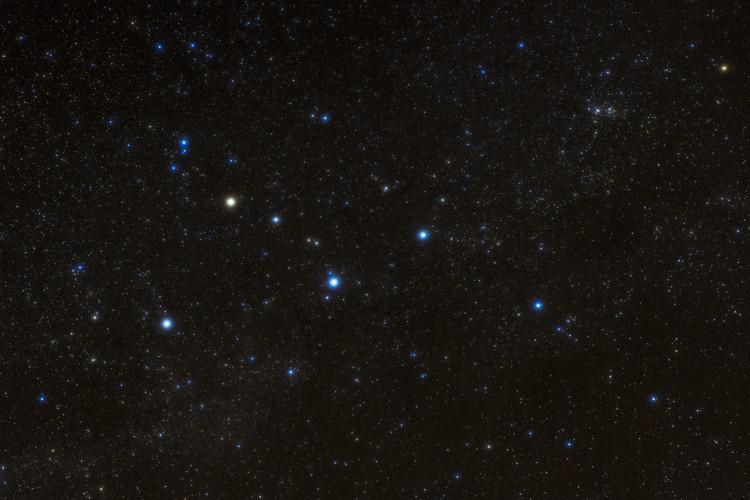This page describes an image Portrait of a Bat
Image caption:
Honourable mention in the 2022 IAU OAE Astrophotography Contest, category Still images of celestial patterns.
Taken in November 2019 from the Doi Inthanon National Park, Chiang Mai, Thailand, this image captures the notable northern constellation Cassiopeia, in the shape of the letter M. Although the official constellation name is the Latinised version of the name of queen “Kasseipeia” from Greek mythology, these five bright stars were considered a constellation in many cultures around the world and they are associated with diverse stories. In Thailand, for example, the constellation represents a Bat, while in Hawaiian culture it is called 'Iwa Keli'i, the chief frigate bird.
For the Navajo in North America, the bright stars are the central part of the celestial mother (of all stars and humans) revolving around the celestial pole together with her husband, the celestial father (of all stars and humans) seen in the constellation of Ursa Major. For the Maya it was part of the huge constellation of the Hole-Backed Caiman, and for the Inuit a Lamp Stand and a Blubber Container.
In ancient China, the bottom-left star was associated with the mythological general Wangliang who drove four horses, represented by the two bright and two fainter stars of the M’s next stroke (from upper-left to lower-middle). The remaining two bright stars and a couple of the other fainter ones are considered a Flying Corridor, a sort of highway, next to the Emperor’s Forbidden Palace that is located at the northern polar region.
On the island of Tonga in the South Pacific, this asterism is considered the Wing of Tafahi and it is not clear if this refers to the shape of the island of Tafahi, or if it is based on an error and originally referred to a wing of the Polynesian hero Tafaki.
The various colours of the stars indicate their temperatures, with redder stars being relatively cooler on their surface than blue and white stars.
Scroll to captions in other languages
Image credit:
Thanakrit Santikunaporn/IAU OAE
DOI: 10.5281/zenodo.7425613
Related glossary terms:
Asterism
, Color
, Constellation
Categories:
Naked Eye Astronomy
Image license: Creative Commons Attribution 4.0 International (CC BY 4.0) Creative Commons Attribution 4.0 International (CC BY 4.0) icons
The media file captions presented on the OAE website were written, translated and reviewed by a collective effort from the OAE, the OAE Centers and Nodes, the OAE National Astronomy Education Coordinators (NAECs) and other volunteers. You can find a full list of credits for our translation project here. All media file captions are released under a Creative Commons CC BY-4.0 license and should be credited to "IAU OAE". The media files themselves may have different licenses (see above) and should be credited as listed above under "credit".
Captions in Different Languages:
Image caption: Lobende Erwähnung beim IAU OAE Astrofoto-Wettbewerb 2022, Kategorie Weitwinkelaufnahmen von Himmelsmustern.
Dieses Bild wurde im November 2019 im Nationalpark Doi Inthanon in Chiang Mai in Thailand aufgenommen und zeigt das auffällige nördliche Sternbild Kassiopeia in Form des Buchstabens M. Obwohl der offizielle Name des Sternbilds die latinisierte Version des Namens der Königin "Kasseipeia" aus der griechischen Mythologie ist, wurden diese fünf hellen Sterne in vielen Kulturen auf der ganzen Welt als Sternbild betrachtet, und sie werden mit verschiedenen Geschichten in Verbindung gebracht. In Thailand beispielsweise steht das Sternbild für eine Fledermaus, während es in der hawaiianischen Kultur als 'Iwa Keli'i oder der oberste Fregattvogel bezeichnet wird.
Für die Navajo in Nordamerika sind die hellen Sterne der zentrale Teil der himmlischen Mutter (aller Sterne und Menschen), die zusammen mit ihrem Ehemann, dem himmlischen Vater (aller Sterne und Menschen), der sich im Sternbild der Großen Bärin (lat. Ursa Major) wiederfindet, um den Himmelspol kreist. Für die Maya war es des riesigen Sternbilds des Kaimans mit dem bemalten Rücken, für die Inuit ein Lampenhalter mit einem Walfett-Gefäß.
Im alten China wurde der linke untere Stern mit dem mythologischen Feldherrn Wangliang in Verbindung gebracht, der vier Pferde lenkte, die durch die zwei hellen und zwei schwächeren Sterne des nächsten Strichs des M (von oben links zur Mitte) dargestellt werden. Die verbleibenden zwei hellen Sterne und ein paar der anderen schwächeren Sterne werden als Fliegender Korridor, eine Art Autobahn, neben dem Verbotenen Palast des Kaisers in der nördlichen Polarregion angesehen.
Auf der Insel Tonga im Südpazifik gilt diese Sterngruppe als der Flügel von Tafahi, wobei nicht klar ist, ob sich dies auf die Form der Insel Tafahi bezieht oder ob es sich um einen Irrtum handelt und ursprünglich ein Flügel des polynesischen Helden Tafaki gemeint war.
Die verschiedenen Farben der Sterne geben ihre Temperaturen an, wobei rötliche Sterne an ihrer Oberfläche kühler sind als blaue und weiße Sterne.
Image credit: Thanakrit Santikunaporn/IAU OAE
Related glossary terms: Asterismus , Farbe , Sternbild Caption translation status: Not yet approved by a reviewer
Caption translators: Carolin Liefke
Image caption: Menzione d'onore al concorso di astrofotografia IAU OAE 2022, categoria Immagini fisse di asterismi.
Scattata nel novembre 2019 dal Parco Nazionale Doi Inthanon, a Chiang Mai, in Thailandia, questa immagine cattura la famosa costellazione settentrionale di Cassiopea, a forma di lettera M. Sebbene il nome ufficiale della costellazione sia la versione latinizzata del nome della regina "Kasseipeia" della mitologia greca, queste cinque stelle luminose sono state considerate una costellazione in molte culture del mondo e sono associate a storie diverse. In Thailandia, ad esempio, la costellazione rappresenta un pipistrello, mentre nella cultura hawaiana è chiamata 'Iwa Keli'i, l'uccello capo delle fregate.
Per i Navajo, in Nord America, le stelle luminose sono la parte centrale della madre celeste (di tutte le stelle e degli esseri umani) che ruota intorno al polo celeste insieme al marito, il padre celeste (di tutte le stelle e degli esseri umani) visto nella costellazione dell'Orsa Maggiore. Per i Maya faceva parte dell'enorme costellazione del Caimano dal dorso forato, mentre per gli Inuit era un supporto per la lampada e un contenitore di grasso.
Nell'antica Cina, la stella in basso a sinistra era associata al generale mitologico Wangliang che guidava quattro cavalli, rappresentati dalle due stelle luminose e dalle due più deboli del tratto successivo della M (da sinistra in alto a metà in basso). Le restanti due stelle luminose e un paio di altre più deboli sono considerate un Corridoio Volante, una sorta di autostrada, vicino al Palazzo Proibito dell'Imperatore che si trova nella regione polare settentrionale.
Nell'isola di Tonga, nel Pacifico meridionale, questo asterismo è considerato l'Ala di Tafahi e non è chiaro se ciò si riferisca alla forma dell'isola di Tafahi o se sia basato su un errore e si riferisca originariamente a un'ala dell'eroe polinesiano Tafaki.
I vari colori delle stelle indicano le loro temperature: le stelle più rosse sono relativamente più fredde sulla loro superficie rispetto a quelle blu e bianche.
Image credit: Thanakrit Santikunaporn/IAU OAE
Related glossary terms: Asterismo , Colore , Costellazione Caption translation status: Approved by a reviewer
Caption translators: Francesco Salvestrini
Caption reviewers: Rodolfo Canestrari









